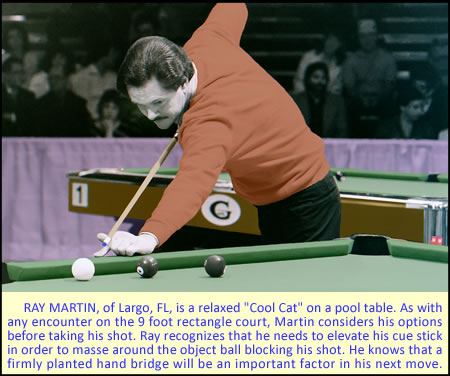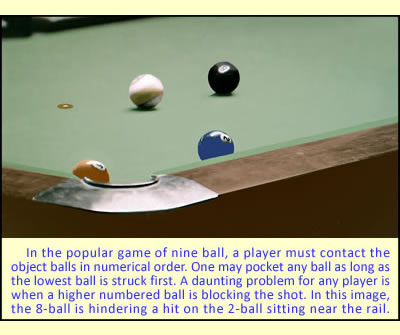.....When I was learning how to play
pool there were no books, no videos, no instructors and no leagues
to play in. The best way to learn was to watch. I was privileged
to see some of the greatest and some of the not so great. My
purpose for publishing my pointers insrtuctional column is not
only to inpart pool knowledge to my viewers but to share with the
public what these great players from the 1980s and 1990s looked
like. Through my trusty Canon, for a moment in time they are immortalized.
Some are still here and some are gone and I still remember the
joy of watching them play.

KANGAROOS AREN'T THE ONLY ONES WITH BIG POCKETS
This is no Kangaroo Court; It's A Pool Table

.....IN POCKET BILLIARDS, the term “Big Pocket” is a figure of speech for a shot that is easier to make because another object ball is in position to help you make the ball you are shooting. Usually, that extra object ball is directly near the pocket one is shooting for, making it in effect a bigger pocket. If the shooter was to miss their shot, the ball could potentially bounce off the rail or go directly into that extra ball, kissing off of it and go into the pocket anyway. And in certain pool games where there is no “call shot” the player has an opportunity to pocket either object ball to continue the run. It's a circumstance every player should look for on the table.
 .....Pictured here from the 1987 McDermott Championship, JENNIFER CHEN of Luodong, Yilan County, Taiwan has the 6-ball lying near the corner making it a ‘larger’ pocket. She is using a
v-bridge hand position on the rail which is explained in another Pointer's article featuring the great Wade Crane. As luck would have it, she is set up with a combination of the 1-ball into the 9-ball and an opportunity to win the game. In this situation, because the 9-ball is on the rail it makes the shot much more challenging. Jennifer was one of the first players to be part of what is affectingly referred to as the Asian Invasion. The China Doll would later become the 1991 China/Japan Women's Pool Champion, among many more competitions. .....Pictured here from the 1987 McDermott Championship, JENNIFER CHEN of Luodong, Yilan County, Taiwan has the 6-ball lying near the corner making it a ‘larger’ pocket. She is using a
v-bridge hand position on the rail which is explained in another Pointer's article featuring the great Wade Crane. As luck would have it, she is set up with a combination of the 1-ball into the 9-ball and an opportunity to win the game. In this situation, because the 9-ball is on the rail it makes the shot much more challenging. Jennifer was one of the first players to be part of what is affectingly referred to as the Asian Invasion. The China Doll would later become the 1991 China/Japan Women's Pool Champion, among many more competitions.
.....Jennifer took keen aim on the combination and made the difficult 9-ball combo. And yes, the nine ball deflected off the six ball to go in.
.....In my view, the first woman Asian player to invade the US was Japan’s MIEKO HARADA. She defeated the then two time US Open Champion, Jean Balukas in one of the first Women’s World Championships in 1973 with a score of 75-55.
But, dear reader, I digress...

.....RAY MARTIN was one the first two inductees into the Straight Pool Hall of Fame in 2011, a label created this year to honor the best players in the history of what was once touted as the game of champions. Martin held the World Champion title in straight pool in 1971, 1974 and 1978; in 1994, he was inducted into the Billiard Congress of America's Hall of Fame. This past August, the 76 year old retired pro pool player entered his first pro championship in over 20 years. He played against the reigning World Champion Oliver Ortmann and was triumphant. As his moniker suggests the Cool Cat approached his next shot in this pictured 9-ball match with a relaxed, determined frame of mind.
.....In this illustration of a big pocket, the five-ball is hovering on the lip of the pocket. The two-ball is about a half diamond above the pocket and a smidge off the rail. This “big pocket” situation, as I formerly pointed out, is a high percentage shot to either make the 2-ball off the five or make the 5-ball on the combination. Not only is it possible to make either ball, but because the two ball is so close to the rail, the cue ball can hit the rail first before contacting the two-ball to make the shot.
I guess we should call this the “big, big pocket” shot. But, dear reader, I digress again…
There was no ‘call shot’ during this tournament.

.....I especially liked the firm bridge Ray made from off the rail proving that hand positions can be versatile. Lining up directly over the cue stick for better sighting, Martin makes what is called a fist bridge. He extended only his index finger while clenching his other three fingers into a fist with his knuckles on the rail. His thumb, which formed a classic v-shape essential in hand positioning, guided the cue...
.....The main problem pictured here is that the 8-ball is blocking the shot. Like butter, Ray elevated the cue stick about 35-degrees, struck the cue ball firmly on the right side and curved around the eight-ball. He hit the rail first and pocketed the two-ball off the five-ball into the big pocket.
...... (See more hand bridges from Ray Martin in an earlier article, the "Closed Half-Bridge"
 . .

.....Pool Pointer Archives
.....1. Closed Half-Bridge
... .2. Look Before You Leap
.....3. Mechanically Inclined
.....4. Keep A Level Cue
.....5. Double or Nothing
.....6. Chalk It Up
.....7. V-Bridge It To Victory
.....8. The Right Combination
.....9. Referees; Unsung heros
...10. Don't Lag Behind
...11. Tongue Twister; Mouth Pool
...12. Read The Right Angle
...13. Don't Let Your Draw Stroke Be a Drawback
...14. Under and Over
...15. Kangaroo Court
.....Tune
in for more Pointer articles coming
your way each month.

|

